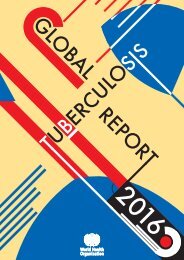patients
DNDi_AR_2015
DNDi_AR_2015
Create successful ePaper yourself
Turn your PDF publications into a flip-book with our unique Google optimized e-Paper software.
LEISHMANIASIS<br />
R&D MODEL & PORTFOLIO<br />
RESEARCH<br />
Leish H2L<br />
(Leishmaniasis Hit to Lead)<br />
PROJECT START: On-going<br />
OVERALL OBJECTIVE: Identify new leads series from current<br />
ongoing Hit-to-Lead activities by taking advantage of the<br />
optimization consortia platform screening of compounds for VL<br />
2015 OBJECTIVE: Progress two new chemical classes into lead<br />
optimization<br />
Hit to lead is a dynamic phase in the drug discovery cascade<br />
in which small molecule hits from high throughput screens<br />
are evaluated and undergo limited optimization to identify<br />
promising lead compounds. Series from a number of different<br />
partners have shown activity against L. donovani; work on<br />
these series to bring forward suitable candidates for lead<br />
optimization is on-going.<br />
Oxaborole<br />
(previously known as Oxaleish)<br />
PROJECT START: January 2010<br />
OVERALL OBJECTIVE: Select an oxaborole for pre-clinical<br />
evaluation<br />
2015 OBJECTIVES:<br />
• Select an oxaborole for pre-clinical evaluation<br />
• Complete profiling of lead oxaboroles<br />
DNDi and Anacor have been working together over the last<br />
few years to identify oxaborole compounds, initially for the<br />
HAT programme, and this has expanded to include both<br />
leishmaniasis and Chagas disease. DNDI-6148 has emerged<br />
as a promising lead candidate and by the end of 2015, studies<br />
including exploratory toxicology necessary for possible<br />
progression to pre-clinical development had been successfully<br />
completed. It is anticipated that pre-clinical development of<br />
DNDI-6148 will commence following a review meeting in January<br />
2016. Approximately four additional oxaborole compounds<br />
continue to be developed behind DNDI-6148 as potential backups<br />
in case an insurmountable issue should be identified.<br />
MAIN PARTNERS: Anacor Pharmaceuticals Inc., USA; Laboratory<br />
of Microbiology, Parasitology and Hygiene, University of Antwerp,<br />
Belgium; London School of Hygiene and Tropical Medicine (LSHTM),<br />
UK; Wuxi AppTech, China; Sandexis, UK<br />
Aminopyrazoles<br />
A notable success in January 2015 was the successful<br />
advancement of the aminopyrazole series from the hit to lead<br />
stage into the next lead optimization stage. This early work<br />
has recently been published in J. Med. Chem. In addition, the<br />
NTD Drug Discovery Booster project commenced in April<br />
2015 working with four pharmaceutical companies: Eisai,<br />
Shionogi, Takeda, and Astra Zeneca and has so far conducted<br />
hit expansion on six different hits which are being developed<br />
for leishmaniasis and Chagas disease.<br />
A number of pharmacokinetic and pharmacodynamic studies<br />
have been conducted in animal models of VL using existing<br />
and experimental drugs to build improved PK/PD models<br />
and ameliorate the translation of new drugs from discovery<br />
into clinical studies.<br />
MAIN PARTNERS: Epichem, Australia; UNICAMP (University of<br />
Campinas, Brazil); Centre for Drug Candidate Optimization, Monash<br />
University, Australia; TCG Lifesciences, India; Sandexis, UK; WuXi<br />
AppTech, China; Laboratory of Microbiology, Parasitology and<br />
Hygiene, University of Antwerp, Belgium; London School of Hygiene<br />
and Tropical Medicine, UK; Griffith University, Australia; GSK, Tres<br />
Cantos, Spain; Sanofi, France; Anacor Pharmaceuticals Inc., USA;<br />
Merck, USA; AstraZeneca, UK; AbbVie, USA; Pfizer, UK.<br />
PROJECT START: February 2012<br />
OVERALL OBJECTIVE: Select an aminopyrazole for pre-clinical<br />
evaluation<br />
2015 OBJECTIVE: Identify compounds suitable for pre-clinical<br />
evaluation<br />
Compound mining of well-annotated chemical compound<br />
libraries has been used to identify a new class of compounds<br />
active against VL. In June 2014, the first in vivo proof of<br />
concept for VL series 12 (aminopyrazoles) from Pfizer was<br />
achieved in the hamster early curative model of VL. An initial<br />
compound gave 93% and 95% reductions in parasitaemia<br />
in liver and spleen respectively after five days oral dosing<br />
at 50mg/kg BID, with a subsequent compound showing<br />
even better in vivo activity (>99% reduction in parasitaemia<br />
in both liver and spleen). The project moved into the lead<br />
optimization stage in January 2015, with GHIT Fund support<br />
and expert scientific assistance from Takeda from April 2015.<br />
Further compounds are being designed and tested. Profiling<br />
of current and new leads in a panel of drug sensitive and drug<br />
resistant strains of Leishmania, exploration of the in vivo dose<br />
response, rat pharmacokinetics, and initial in vitro safety<br />
assays are all underway. A full lead optimization programme<br />
is ongoing and we aim to select an optimized lead in 2016.<br />
MAIN PARTNERS: Takeda Pharmaceutical Company Ltd, Japan;<br />
Wuxi AppTech, China; Laboratory of Microbiology, Parasitology and<br />
Hygiene, University of Antwerp, Belgium; London School of Hygiene<br />
and Tropical Medicine, UK; Pfizer, UK; Sandexis, UK<br />
DNDi Annual Report 2015 › 29



